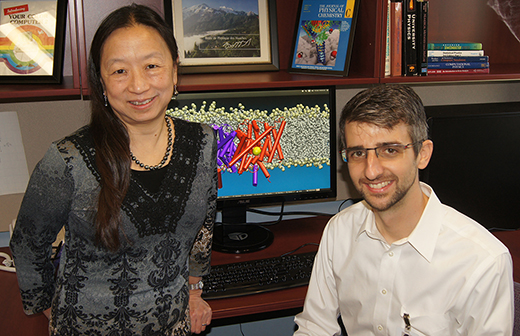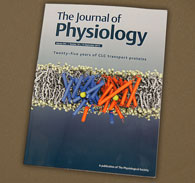Pair of Kansas State University faculty members cover the topic of CLC transport proteins in latest physiology journal
Tuesday, Oct. 13, 2015

Kansas State University's Peying Fong works with Jeffrey Comer on a 3-D model of a CLC transport protein that Comer created to accompany her editorial in the Sept. 15 issue of The Journal of Physiology. | Download this photo.
MANHATTAN — A chloride channel may sound like the latest addition to the cable television lineup, but two Kansas State University researchers are helping to show — including in 3-D — why knowing more about this family of transport proteins may unlock mysteries behind some genetic diseases.
The Sept. 15 issue of The Journal of Physiology highlights Peying Fong and Jeffrey Comer from the College of Veterinary Medicine's anatomy and physiology department for their independent contributions on the featured topic of CLC — or chloride channel — transport proteins.
Fong is an associate professor who is also a senior editor for The Journal of Physiology. She commissioned the five featured invited reviews and edited additional submissions comprising the journal's special section, "Twenty-five years of CLC transport proteins." She also wrote the lead editorial, which recognizes the landmark achievements leading to understanding this important family of transport proteins, the dysfunction of which has been associated with what Fong describes as a "constellation of human genetic diseases."
"One such human disease is myotonia congenital," Fong said. "Mutations in the corresponding gene in goats underlie the characteristic 'fainting' behavior displayed by the Tennessee fainting goat."
Comer is an assistant professor whose research focuses on the molecular simulation of interactions between biological molecules and synthetic nanostructures. He is also a core faculty member of Kansas State University's Institute for Computational Comparative Medicine and the Nanotechnology Innovation Center for Kansas State. Much of his work involves creating digital, 3-D models of such structures. He contributed the cover artwork for this issue of the journal.
"I had various illustrations that were available, but Dr. Comer's rendering was a much better choice for the cover," Fong said.
"Proteins are tiny machines that make our bodies work, and being able to visualize them is essential for understanding animal and human health," Comer said. "Using the same technologies that go into animated movies and video games, we can actually see what microscopic proteins look like and understand how they work."
Fong became aware of the discovery of the first CLC transport proteins early in her research career.
“I subsequently was lucky enough to land a fellowship to work in the very lab that discovered the first CLC transport proteins," Fong said. "Many exciting discoveries were made since then. In my editorial, I place into context how these insights into understanding the structure, function and regulation of CLC transport proteins have influenced related subdisciplines, as well as medicine, in ways that cannot be overestimated."
"Dr. Fong's and Dr. Comer's editorial contributions are an excellent example of the many and varied ways that our faculty members contribute to our profession and extend our understanding of scientific discoveries," said Frank Blecha, associate dean for research in the College of Veterinary Medicine and university distinguished professor of immunophysiology. "We are fortunate that these two scientists unselfishly share their expertise and time with their colleagues."

